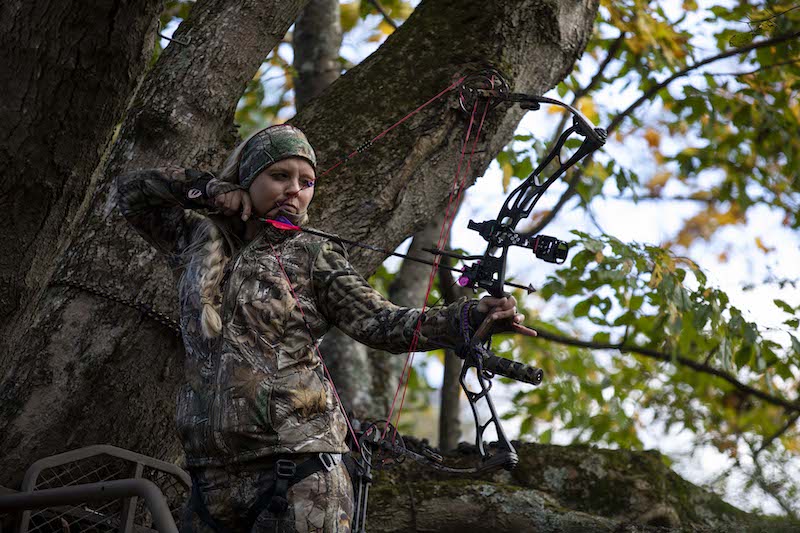There’s something simple and primitive about recurve bows.
And there’s something powerful and modern about compound bows.
So which should you choose?
That depends on your interests and what you want to accomplish with a bow and arrow. Must you have the latest and greatest in machinery and electronics? Or are you a minimalist?
Some people covet the newest cell phones as soon as they’re released. They explore everything the phone can do, and always wish for more. Others hang onto one phone as long as possible, and use few of its infinite functions.
Just looking at a compound bow next to a recurve, you see the recurve’s simplicity compared to the compound’s advanced engineering. Different people are drawn to each based on the bows’ looks.
Compound bows are easier to draw, aim and shoot. Their cams or wheels roll over during the draw cycle to reduce the bow’s draw weight at full draw. That let-off goes as high as 90%, meaning archers only hold 7 pounds at full draw on a bow with a 70-pound peak draw weight.
Repeatability is critical to accuracy. You must do the same thing the same way shot after shot to be consistent. Compound bows have defined draw stops. You can only draw the bowstring so far before part of the cam hits a limb or cable, which stops the cycle. That ensures the bow’s power stroke is the same for each shot.
Archers shoot compound bows with mechanical release-aids, or triggers. These devices allow precise, identical arrow releases for each shot.
Recurves involve more variables. For starters, they offer no mechanical help. Your strength alone makes the bow work. The farther you draw the bowstring, the heavier the draw weight becomes, and it never lets off. An archer shooting a 50-pound recurve bow holds all 50 pounds at full draw, assuming the archer draws to 28 inches.
Recurves have no draw stop. You can draw a 60-inch recurve bow to nearly 40 inches. It’s up to the archer to stop drawing at the same spot each time before releasing the string. Accuracy varies greatly for archers who don’t stop drawing at the same spot each time.
Archers draw recurve bowstrings and release the arrow with their index, middle and ring fingers. They might wear a glove or use a swatch of leather called a “tab” to protect the drawing fingers, but those fingers still hold the draw weight and release the string. Accuracy suffers if any one of those fingers do something different for each shot.
All compound bows are built to attach accessories like rests, sights and stabilizers. Some recurves are built for aiming and stabilizing accessories, but others are meant to be shot without attachments.
If you talk to recurve and compound archers, you’re more likely to hear recurve shooters wax poetic about their relationships with their bows. They’ll discuss how the bow feels in their hands, and how they believe it’s an extension of their bodies.
You generally don’t hear compound archers talk like that. They view the bow as more of a tool. They might have one bow for shooting indoor competitions, another for 3D tournaments, and still another for hunting. Recurve archers more often use the same bow for all three activities because they rely on their familiarity with the bow to shoot well.

Do you plan to hunt with your bow? If so, think about its draw weight. If a state specifies a minimum draw weight for bowhunting deer, it’s usually about 35 pounds. That’s considered the least amount of force needed to drive an arrow through a deer.
Many recurve bowhunters use bows with 40- to 50-pound draw weights. They hold all that weight on their fingertips until releasing their arrow at an animal. Compound-bow hunters commonly shoot 50- to 70-pound draw weights. Thanks to the bow’s mechanical let-off, bowhunters might hold only 5 to 10 pounds at full draw. They’ll also have a mechanical release-aid to help them reach full draw.
Because of the recurve’s reduced draw weight, its effective hunting range is generally less than a compound’s. For some bowhunters, the ultimate challenge is getting as close as possible to game. Others like to maximize their shooting range, while still being accurate.
If you want a bow for competition, you’ll find distinct divisions in almost every tournament for recurves and compounds. But if you dream of reaching the Olympics, recurves are currently your only option unless the rules change to accommodate compound bows.
In competition, scores shot with recurve bows typically will be lower than those shot with compounds. And scores shot by barebow recurve archers will likely be the lowest of all.
Most archers find it faster and easier to achieve accuracy with compound bows than with recurve bows. That might sound like a strike against recurves, but some archers prefer that challenge more than the easier precision of compounds.
What do you prefer?




